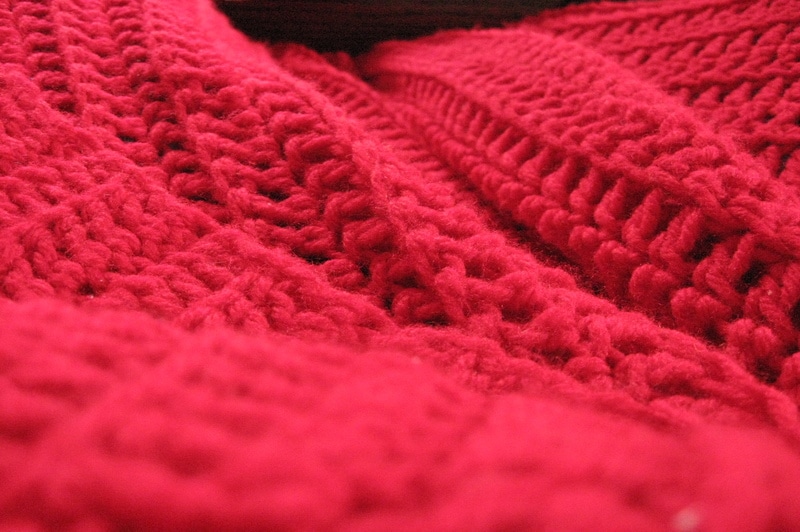Eager to know how to wash a knit blanket inside the comfort of your home?

Not so fast; you need to think of a washing method appropriate for the fiber first. Although to be frank, the trusted way of doing it is by hand.
In this tutorial, we will help you decide what’s best for your blanket. You can follow the simple steps listed below to help you keep track of the process.
Also, we answered common questions to help you in decision-making.
Know The Type of Yarn
Do you recall making the blanket yourself? If so, run to the yarn’s care instructions to have a clear idea of dos and don’ts.
However, if the blanket is purchased, or if you have thrown away the thread already, you could gamble on guesswork by texture or appearance.
One simple trick you can do is to burn loose threads. The remnant ashes are telltale signs of the material, and the smell produced gives further clues.
Do this by cutting a small section or pulling away tassels from the blanket.
Here is how to tell apart cotton, acrylic, wool, and polyester from each other. With cotton, the fiber should feel cold, as opposed to acrylic and wool that holds heat long after.
Once burned, the consistency of ash left by cotton is fine and will smell of leaves.
When it comes to wool, the texture is rough. Expose it to a flame, and expect to smell dampened fur from a wet dog. The ash left behind is hard and crumbles to the touch.
Now, please don’t fall prey to the similar feel of wool and confuse it with acrylic. Yes, they are the same, but acrylic has no smell whatsoever—except when burned.
You can quickly tell because it melts and produces smoke, creating a chemical odor.
Finally, polyester stands out the most because of its sweet odor. It burns quickly but leaves no trace of ash.
Instead, it produces melted drops, along with noticeable black smoke.
Tips On How To Wash A Knit Blanket
- What if items have holes that need repair? Well, in that case, you can repair it yourself by using a graft stitch. Although, if the gap is too small, you can grab a needle and stitch it close.
If you’re not confident enough, you can hire a knitter to repair the damage. Professional knitters know precisely how to fix the problem at hand.
Also, they probably have the right colors of thread to match your blanket.
- If you have stubborn stains, treat them by directly pouring a drop or so of detergent on the area. Rub the spot and let it sit for a while before washing.
Find a cloth, dip it in water, and “rinse” until the stain goes away.
- Hot water is a deal-breaker for knitted blankets. Never use them lest the fiber melt, spoiling the item or causing shrinkage.
Now we will proceed to the two options of cleaning methods. All blankets are different and will need attention to care. In this regard, the care label is your go-to in choosing which works best.
Method #1. Machine Wash
- Step #1. Choose a mild detergent.
- Step #2. Place the knit blankets inside a mesh laundry bag.
- Step #3. Wash with cold water on a gentle cycle for linen and cotton and normally wash with other items.
- Step #4. Tumble dry the blanket.
Method #2. Hand Wash
- Step #1. Choose a detergent that is gentle for hands.
- Step #2. Proceed to hand washing.
- Step #3. Mix detergent with cold water and soak the blankets.
- Step #4. Rinse the blanket with cold water in a new basin.
- Step #5. Gently squeeze the blanket of excess water.
- Step #6. Hang the blanket in a place with good airflow.
Should I wash by hand or machine?
Whether you should wash by hand or machine will rely upon the type of yarn.
With fibers such as cotton, polyester, or acrylic, you have the green light to machine wash.
Otherwise, for wool, and rarely, for more expensive fabrics like cashmere, prefer hand washing on cold water to avoid damage.
Which detergent should I use?
To protect your hands during hand washing, opt for detergent formulas that are mild to the skin and delicate to fabrics.
Choosing a suitable detergent is just as important as the cleaning method, along with water temperature. When you wash, use cold water, and do the same when rinsing.
In the particular case of wool, look for detergent containing lanolin. Not only does it preserve wool fibers, but this natural oil will also maintain the pristine condition a little longer.
For wool, strictly wash in cold water to keep the woven fibers intact, while for synthetic or cotton ones, freely choose between warm or cold water.
Conclusion
Knitted blankets keep us warm and cozy during cold nights. Although they are treasured, not everyone knows how to wash a knit blanket at home.
Paying for dry cleaning will only hurt your pockets, so a more practical move is to clean it yourself.
